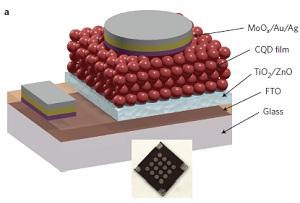River subbasins more depleted than
official figures show
09 April 2024
Published online 31 July 2012

Whereas semiconducting materials commonly used in photovoltaic cells convert only a portion of the sun's rays into electricity, colloidal quantum dot (CQD) materials can convert energy from the entire solar spectrum. By controlling the size of the semiconductor nanoparticles — quantum dots — researchers can make the material harness different frequencies of light.
Researchers from University of Toronto, Canada, and King Abdullah University of Science and Technology (KAUST) in Thuwal, Saudi Arabia, have made the most efficient CQD cell yet. Using a combination of organic and inorganic chemistry, they have been able to eliminate electron 'traps' associated with the large internal surface areas of the nanoparticles, and keep the films so dense that they absorb as much light as possible.
"By introducing small chlorine atoms immediately after synthesizing the dots, we're able to patch the previously unreachable nooks and crannies that lead to electron traps" says Alex Ip, one of the co-authors of the paper published in Nature Nanotechnology. "We follow that by using short organic linkers to bind quantum dots in the film closer together."
This twofold process of 'hybrid passivation' was shown to lead to record film densities by Aram Amassian's group at KAUST, which discerned the structure of the CQD films at subnanometer resolution using state-of-the-art synchotron X-ray scattering methods.
These advances open up new avenues for the improvement of CQD cell efficiencies, bringing the prospect of low cost solar energy nearer.
"This work shows that the abundant materials interfaces inside colloidal quantum dots can be mastered in a robust manner, proving that low cost and steadily-improving efficiencies can be combined," says Ted Sargent, who co-led the group in partnership with KAUST's Amassian.
doi:10.1038/nmiddleeast.2012.106
Stay connected: